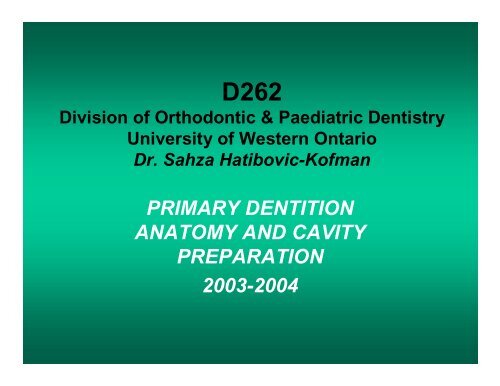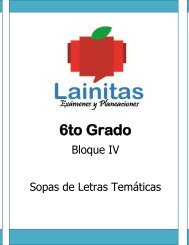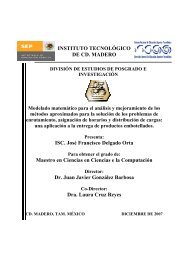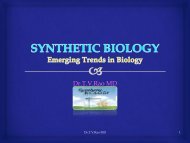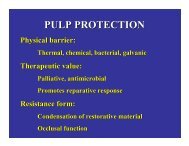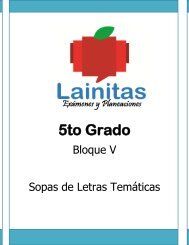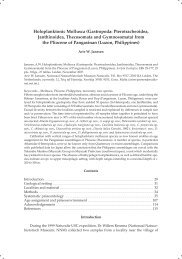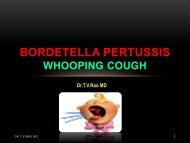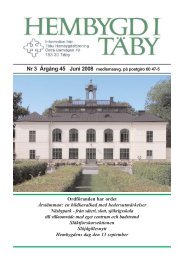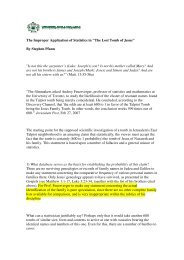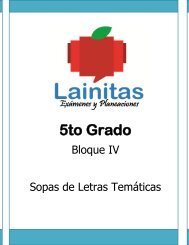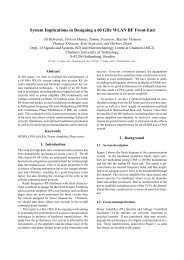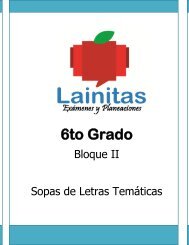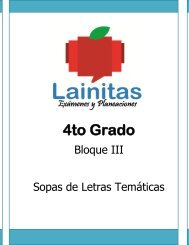D262 Primary Dentition Anatomy & Cavity Prep 2003-2004
D262 Primary Dentition Anatomy & Cavity Prep 2003-2004
D262 Primary Dentition Anatomy & Cavity Prep 2003-2004
Create successful ePaper yourself
Turn your PDF publications into a flip-book with our unique Google optimized e-Paper software.
<strong>D262</strong>Division of Orthodontic & Paediatric DentistryUniversity of Western OntarioDr. Sahza Hatibovic-KofmanPRIMARY DENTITIONANATOMY AND CAVITYPREPARATION<strong>2003</strong>-<strong>2004</strong>
GENERAL OBJECTIVES:To present the anatomy of primaryteeth and key anatomical differencesbetween primary and permanent teeththat influence cavity preparation.
SPECIFIC OBJECTIVES:(1) Describe the general morphologicaldifferences between primary andpermanent teeth and their clinicalimplications.(2) Identify special features and location of theroots of primary teeth. Comment onclinical applications.(3) Describe the general morphology of thedental pulp, location of the pulp horns andorifices of canals in the primary teeth.Comment on clinical considerations.
Specific Objectives (continued):(4) Identify histological differences betweenthe pulp of primary and permanent teethand the clinical relevance.(5) Identify the reason for most restorativeproblems in paediatric dentistry.(6) Describe the principles of operativedentistry.(7) Describe the steps for preparation andrestoration of Class I and Class II amalgamrestorations.
Specific Objectives (continued):(8) Describe common errors in Class I and IIrestorations.(9) Describe the differences in cavitypreparation when composite is used asa restorative material for primary teeth.
Most problems in paediatricdentistry occur because of• failure to prepare and restore the teeth in away that takes into account their:ANATOMIC or MORPHOLOGIC structuralcharacteristics and limitations.
ANATOMIC CONSIDERATIONS OFPRIMARY TEETH1. Crowns of primary teeth are smaller, andmore bulbous than permanent teeth.2. Both lingual and buccal walls of theprimary teeth taper occlusally, thereforethe occlusal surface is quite narrow.3. <strong>Primary</strong> teeth demonstrate greater cervicalconstriction and have more prominentcervical enamel contour than permanentteeth.
Anatomic considerations (continued)4. <strong>Primary</strong> teeth have thinner enamel anddentin than permanent teeth.5. The pulp of primary teeth are larger inrelation to the crown than permanent teeth.The pulp horns of primary teeth are closerto the outer surface of the tooth than forpermanent teeth.The MESIOBUCCAL pulp horn is the most prominent.
Anatomic considerations (continued)6. Fine canals.7. Thin pulpal floor.8. The roots of primary teeth are long, slenderand curved. Interradicular space canaccommodate the developing permanenttooth.9. In primary teeth the enamel rods of thegingival third of the crown extend in anocclusal direction. The rods of thepermanent teeth extend in a cervicaldirection.
Anatomic considerations (continued)10. <strong>Primary</strong> teeth have broad, flat proximalcontact areas.11. <strong>Primary</strong> teeth are whiter in colour thantheir permanent successors.
PRINCIPLES OF OPERATIVEDENTISTRYGain access.Establish outline formEliminate caries.Establish resistance and retention form.Refinement and debridement of the cavity.
RESTORATIVE TRAY - SPEC1. Mirror2. Explorer3. Cotton pliers4. Small spoon5. Large spoon6. Hatchet7. Small condensor8. Large condensor
Restorative Tray (continued)9. T-3 (Beaver tail)10. Discoid-cleoid11. Burnisher12. G-38 (gold knife)13. PFI (black felt)14. Syringe
INFORMATIONIn order to provide the best care for the childpatient and teach excellence, we, at thechildren’s clinic, have decided to use toothcolouredmaterials and stainless steel crowns asa first choice of treatments.Occasionally other materials will be usedaccording to the medical indications and/orchild/guardian demand.
Montreal, November 27, 2000It was very refreshing for us, as clinicians, to hear from auniversity professor that the University of WesternOntario actually teaches dental materials and techniquesthat are up-to-date, in order to prepare the students tothe challenges of everyday clinical dental pediatricpractice.… J. Victor LegaultQuebec Assoc. of Pediatric Dentists
COMPOSICIÓN INDUSTRIAL POR MUNICIPIODORADO (051)SEGUNDO TRIMESTRE 2011INDUSTRIA NAICS UNIDADESEMPLEOPROMEDIOSALARIOSTOTALESSALARIOTRIMESTRALPROMEDIOTOTAL 442 7,243 42,025,060 5,802AGRICULTURA, BOSQUE, PESCA Y CAZA 11 5 77 356,754 4,653MINERIA 21 2* * *ELECTRICIDAD, AGUA Y GAS 22 2* * *CONSTRUCCION 23 20 426 2,401,462 5,642MANUFACTURA 31-33 25 1,369 12,111,059 8,849ALIMENTOS 311 3* * *PRODUCTOS DE TABACO Y BEBIDAS 312 1* * *TEXTILES 313 0 0 0 0PRODUCTOS TEXTILES EXCEPTO ROPA 314 0 0 0 0ROPA 315 0 0 0 0CUERO Y PRODUCTOS RELACIONADOS 316 1* * *PRODUCTOS DE MADERA 321 1* * *PAPAEL 322 0 0 0 0IMPRENTA E INDUSTRIAS RELACIONADAS 323 0 0 0 0PRODUCTOS DE PETROLEO Y CARBON 324 1* * *PRODUCTOS QUIMICOS 325 4 375 3,406,550 9,076PRODUCTOS DE GOMA Y PLASTICOS 326 1* * *PRODUCTOS MINERALES NO METALICOS 327 3 129 1,470,163 11,426INDUSTRIAS DE MATERIALES PRIMARIOS 331 0 0 0 0PRODUCTOS DE METAL 332 0 0 0 0MAQUINARIA 333 5 89 534,052 5,978COMPUTADORAS Y PRODUCTOS ELECTRONICOS 334 1* * *EQUIPO Y APARATOS ELECTRICOS 335 0 0 0 0EQUIPO DE TRANSPORTACION 336 1* * *MUEBLES Y PRODUCTOS REALCIONADOS 337 1* * *INDUSTRIAS MANUFACTURERAS MISCELANEAS 339 2* * *COMERCIO AL POR MAYOR 42 23 118 800,182 6,800COMERCIO AL DETAL 44-45 79 1,049 5,241,257 4,998TRANSPORTACION Y ALMACENAMIENTO 48-49 9 34 392,613 11,435INFORMACION 51 5* * *FINANZAS Y SEGUROS 52 12 64 411,658 6,432BIENES RAICES, RENTA O ARRENDAMIENTO 53 20 57 280,006 4,884SERVICIOS PROFESIONALES TECNICOS 54 26 131 1,301,945 9,913GERENCIA DE COMPANIAS Y EMPRESAS 55 0 0 0 0SERVICIOS ADM. Y DESPERDICIOS SOLIDOS 56 27 633 3,550,647 5,612SERVICIOS EDUCATIVOS 61 7 874 5,611,274 6,418SERVICIOS DE SALUD Y ASISTENCIA SOCIAL 62 65 217 1,167,874 5,374ARTE, ENTRETENIMIENTO Y RECREACION 71 6* * *ALOJAMIENTO Y SERVICIOS DE ALIMENTOS 72 49 907 2,463,808 2,715OTROS SERVICIOS EXCEPTO ADM. PUBLICA 81 41 147 646,576 4,398ADMINISTRACION PUBLICA 92 17 945 4,264,102 4,511OTROS (ESTABLECIMIENTOS NO CLASIFICADOS) 99 2* * *FUENTE: PROGRAMA QCEW (SOURCE: QCEW PROGRAM)CODIFICACIÓN INDUSTRIAL NAICS A DOS Y TRES DÍGITOS (TWO AND THREE DIGIT NAICS CODE)0 = NO EXISTEN ESTABLECIMIENTOS EN ESTA INDUSTRIA (0 = NOT EXIST ESTABLISMENT ON THIS INDUSTRY)*DATOS NO INFORMADOS POR IDENTIFICACIÓN PERO INCLUIDOS EN EL TOTAL (DATA NOT REPORTED DUE TO IDENTIFICATION BUT INCLUDED ON THE TOTAL)30
Information (continued)Hybrids:1. Resin-modified glass ionomer cement(RMGIC).2. Polyacid-modified resin compositematerials (PMRC), compomer.
Information (continued)The restorative material for primary teethshould possess the following properties:• be biocompatible• join a strong adhesive bond to remindedtooth• strengthen residual tooth structure• easy handling characteristic• be economical
Information (continued)Amalgam is good material and has been usedsuccessfully for about 200 years, but toothcoloured materials accompanied with thebonding systems offer advantages overdental amalgam in:• Preservation of healthy tooth structure.Today literally we can restore a tooth byremoving only decayed structure. Toaccommodate amalgam a lot of healthytooth structure has to be removed toprovide mechanical retention of therestoration.
Information (continued)• Repairability.• Esthetics.• Release of fluoride.Our students are performing high quality carefor the child patient and will be using the mostcurrent tooth-coloured materials.
GUIDELINES for Usage of theRestorative Materials in Mixed <strong>Dentition</strong>First step in restorative dentistry is to performgood caries diagnosis and elimination of thelesion.Under diagnosis = misdiagnoses.In the SPEC clinic after visual diagnosis, wewill use regularly light caries detector“DIAGNOdent” and/or dye caries detector“Seek and Sable”.
STATE OF THE TOOTHTREATMENT• Caries free primary andpermanent teeth• Pit and fissure sealants• Small decalcification• Bur preparation or airabrasion - pit and fissuresealants• Small lesion in dentinocclusally• <strong>Cavity</strong> preparation, anduse caries seek andrestore it with composite
STATE OF THE TOOTHTREATMENT• MO or DO• DO or MO next topermanent tooth ifexfoliation will occurwithin two years.• Conservativepreparation withoutextensions forprevention and usecombination of flowableand filled composite.• Conservative cavitypreparation and glassionomer cement.
Guidelines (continued)• Multi surface lesions and teeth after pulptherapy will be restored with stainless steelcrown (SSC).
STEPS FOR PREPARATION ANDRESTORATION OF CLASS IAMALGAM RESTORATIONS• Administer appropriate anaesthesia and placethe rubber dam.• Using a No. 330 bur gain access and penetrateinto the tooth to a depth of 0.5 mm into dentin.• Removal all carious dentin by using large,round bur.• Provide retention and resistance by makingcavity surface parallel with its externalsurface.
Steps Class I (continued)• Smooth the enamel walls and refine the finaloutline form with No. 330 bur.• Place pulp protection as needed.• Place and condense amalgam.• Carve amalgam.• Burnish the carved amalgam when it hasbegun its initial set and resists deformation.• Remove the rubber dam and check theocclusion.
COMMON ERRORS WITH CLASS IAMALGAM RESTORATIONS• Not including all susceptible fissures.• <strong>Prep</strong>aring the cavity too deep.• Undercutting the marginal ridges.• Carving the anatomy of the amalgam too deep.• Not removing the amalgam flash from thecavosurface margins.• Undercarving, which leads to fracture of theamalgam from hyperocclusion.
STEPS FOR PREPARATION ANDRESTORATION OF CLASS IIAMALGAM RESTORATIONS• Administer appropriate anaesthesia and placethe rubber dam.• Place a wooden wedge in the in interproximalarea.• With No. 330 bur in the high speed turbinehandpiece, prepare the occlusal outline format the ideal depth.
Steps Class II (continued)• To prepare the proximal box, use the same burmoving it buccolingually in a pendulummotion and in a gingival direction. Thecontact should be broken between theadjacent tooth gingivally, buccally andlingually.• Remove any remaining caries.• Round axiopulpal line angle.• Remove any unsupported enamel off thebuccal, lingual and gingival walls.
Steps Class II (continued)• Place pulp protection if necessary.• Remove the wedge, place a matrix band, andreinsert the wedge.• Condense amalgam.• Carving of the occlusal portion is performedwith a small carver. The marginal ridge can becarved with the tip of the explorer.• Remove the wedge and the matrix.• Gently floss the interproximal contact.• Burnish the restoration.• Remove the rubber dam and check occlusion.
PROCEDURE OF CLASS II CAVITYPREPARATION FOR COMPOSITERESTORATION1. A local anaesthetic will be administered inthe usual fashion and in the appropriateamount to ensure adequate anaesthesiaduring the procedures.2. A rubber dam will be used routinely.3. Wooden wedges will be inserted in theproximal areas to maximize the protectionof gingiva and the adjacent tooth, andprotection from tearing the rubber dam bybur.
Procedure Class II(continued)4. The outline form of the cavity preparationswill be conservative as presented in thepicture.5. No flaring buccal and lingual walls of theproximal box.6. Caries has to be completely removed,please use seek and sable.7. The line angles will be rounded slightly,but the cavity will not be extended forprevention.8. Do not remove healthy and unsupportedenamel.
Procedure Class II(continued)9. Rinse the cavity.10. A “cure-thru” celluloid matrix band oronmi-paedo matrix will be inserted firmlyinto place.11. Acid etch the cavity for 25 seconds.12. Rinse it for 20 seconds.13. Rub in one bottle bonding system, air dryand cure for 10 seconds.14. Apply flavable composite on the edgescure it.
Procedure Class II(continued)15. Restore with filled composite (do goodmodeling to be able to avoid finishing).16. Cure for 40 seconds.17. The matrix band will be removed and therestoration will be finished and polished.Finishing and polishing will be done byusing finishing and polishing discs andstrips.18. The rubber dam will be removed and theocclusal contacts evaluated and adjustedas necessary.
Procedure Class II(continued)19. Any tooth with carious or iatrogenic pulpinvolvement will obtain pulp treatment, andstainless steel crown.
OBJECTIVES:PREVENTIVE RESINRESTORATION (PRR)1. List the indications and contra-indicationsfor PRR for primary and permanent teeth.2. Describe the PRR materials.3. Describe the clinical procedures for PRR.4. Identify the advantages of using PRR andtheir cost effectiveness.
PRR (continued)Non-surgical management of initial cariouslesions by remineralizaiton offers anopportunity to extend preventive dentistryinto early therapy.It is now recommended, for smooth surface,that cavity preparation and restorationplacement is appropriate only after thelesion has progressed into the dentin.
<strong>D262</strong>Division of Orthodontic & Paediatric DentistryUniversity of Western OntarioDr. Sahza Hatibovic-KofmanRUBBER DAM AND MATRIXAPPLICATION2002-<strong>2003</strong>
GENERAL OBJECTIVES:• Discuss the armamentarium andapplication of the rubber damin paediatric patients.
SPECIFIC OBJECTIVES:(1) Identify the need, indications and relativecontraindications for the paediatric patient.(2) State the advantages of rubber dam anddescribe its preparation for a paediatricpatient.(3) Describe clamps and their applications.(4) Describe the explanation of the rubber damto the child.(5) Select and apply the matrices for Class IIpreparations in primary molars.
INDICATIONS:All paediatric restorative procedures should becompleted with the rubber dam in place.RELATIVE CONTRINDICATIONS:(1) Fixed orthodontic applicance.(2) Partially erupted teeth.(3) A child with upper respiratory infection.
ADVANTAGES:1. Saves time.2. Improvement of access.3. Controls saliva.4. Retraction and protection of soft tissues.5. Prevention of the ingestion and inhalationof foreign bodies.6. Provision of aseptic environment.7. Aid management.8. Helps the dentist to educate parents.
Retrospective Clinical Studyof Vitalescence in <strong>Primary</strong>Molars
Table 1: Clinical Performance ofVitalescence in <strong>Primary</strong> MolarsA Three-Year StudyToothNumber ofTeethRestoredFAILURESUCCESS# % # %Upper 1 st 106 12 11.32 94 88.68Lower 1 st 122 9 7.38 113 92.62Upper 2 nd 191 16 8.38 175 91.62Lower 2 nd 171 9 5.26 162 94.74TOTAL 590 46 7.80 544 92.20
Table 2 - Success/Failure of Amalgam andComposite Restoration in SPEC Clinic andPrivate Practice - A Two-Year StudyAMALGAMCOMPOSITELocation SPEC PRIVATEPRACTICESPECPRIVATEPRACTICE%Success%Failure%Success%Failure%Success%Failure%Success%Failure96 4 95 5 93.7 6.3 96.3 3.7
100908070Percent (%)6050403020100Amalgam inSPECComposite inSPECAmalgam inPaediatricPracticeComposite inPaediatricPractice1 Year 2 Year
In order to provide the best care for thechild patient and to teach excellence, we,at the Children’s Clinic at the Universityof Western Ontario, have decided to usetooth–colouredmaterials as the firsttreatment of choice as of July 18, 2000.


